Designing with Blue: Transform Your Living Room
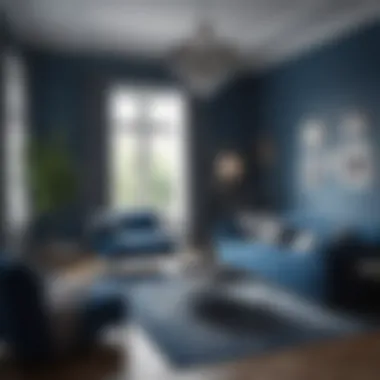
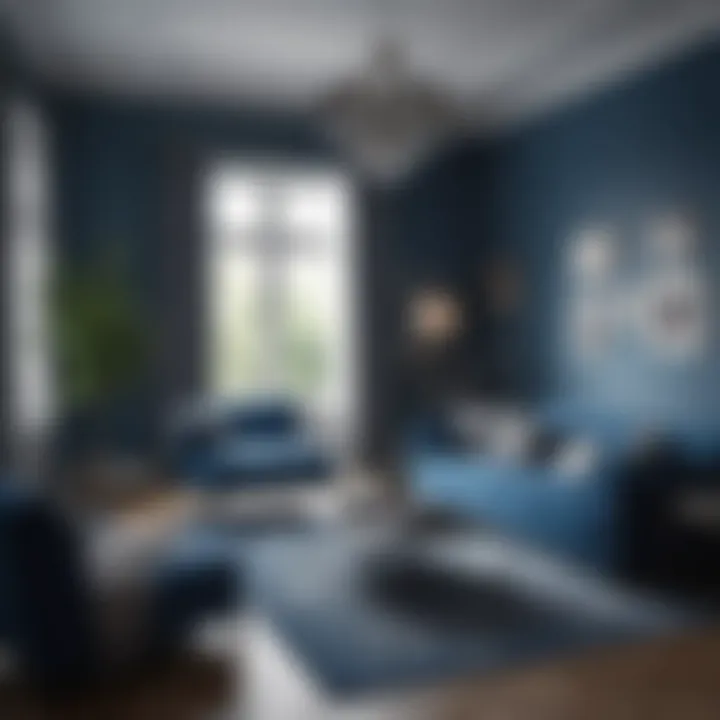
Intro
The living room serves as the heart of a home, making its design critical for both functionality and aesthetic appeal. The colour blue is often associated with tranquility and calmness. In recent years, it has become increasingly popular in interior design, particularly in living rooms. This article will delve into the multifaceted nature of blue in living room decor, exploring its psychological effects, practical uses, and aesthetic versatility.
Integrating blue can transform a space into a serene retreat or a vibrant gathering place, depending on the chosen shade and décor. A well-designed blue living room not only lifts the mood of its inhabitants but can also enhance the overall atmosphere of the home.
Key areas of focus will include:
- The significance of various shades of blue and their psychological impacts.
- Practical applications of blue in furniture and decor choices.
- Considerations for natural lighting to accentuate blues.
- Common pitfalls to avoid when utilizing blue tones in design.
The aim is to offer a comprehensive guide for homeowners and design enthusiasts looking to incorporate blue into their lives.
Design Inspiration
Designing with blue can lead to beautiful results when one considers both trending styles and complementary colour palettes. Taking inspiration from various sources can help in crafting a cohesive and inviting space.
Trending Styles
Contemporary interior design trends frequently highlight the use of blue, particularly the deeper shades. Dark navy or teal can add richness to a living room. Consider the following styles when working with blue:
- Minimalist: Blue can create a clean and simple space with an emphasis on functionality.
- Eclectic: Mixing different patterns and textures alongside blue provides an energetic and unique atmosphere.
- Coastal: Light blues and turquoise evoke the essence of the beach and can create a relaxing environment.
Color Palettes
Pairing blue with appropriate colors is essential for creating harmony in a room. Some effective combinations include:
- White and Blue: A classic combination that promotes cleanliness.
- Gray and Blue: Offers a modern feel while remaining sophisticated.
- Yellow and Blue: Brings energy and warmth, creating an inviting space.
"The key to a successful blue living room lies in the careful selection of shades and their pairings with other colours."
Practical Tips
Once inspiration is gathered, translating those ideas into practical steps is paramount for a successful design process. This includes maintenance, care, budgeting, and planning effectively.
Maintenance & Care
Keeping the blue in your living room looking fresh requires some ongoing effort. Here are some tips:
- Regular Cleaning: Dust and dirt can become more visible on lighter shades. Include regular dusting and vacuuming to maintain clarity.
- Protection: Use upholstery fabric that resists stains, especially if you have pets or children.
Budgeting & Planning
Creating a blue-themed living room can be done on various budgets. Consider these aspects:
- Furniture: Investing in a few key pieces like a navy sofa can set a strong anchor for the design.
- Accessorizing: Incorporate blue through smaller items such as cushions and vases, which can be budget-friendly yet impactful.
Intro to Blue in Interior Design
The color blue holds significant value in interior design, influencing both aesthetic and emotional responses. Integrating blue into a living room creates a unique atmosphere. This aspect of design is critical in guiding homeowners and enthusiasts in achieving their desired ambiance while considering practical applications.
The various shades of blue can shift the mood of a room from tranquil to sophisticated, enabling thoughtful expressions in space. Furthermore, it stands as a versatile backdrop for various styles, accommodating contemporary and traditional designs alike.
In this article, we will explore the multifaceted nature of blue in interior spaces. Such exploration includes understanding the psychological impact and historical context of this color in design. This background enables users to navigate their design choices effectively, tailoring the environment to their preferences.
The Psychological Impact of Blue
The psychological effects of blue are profound. Blue has been associated with serenity and calmness. Studies indicate that this color can lower heart rates and create a sense of peace. This makes it an ideal choice for a living room, where relaxation and socializing occur.
Moreover, different shades of blue induce varied emotional responses. Light blues may evoke feelings of freshness and space, while deeper blues often evoke thoughts of depth and stability. For example, a soft sky blue can enhance feelings of freedom, whereas a navy blue might convey formality and trustworthiness.
Choosing blue is not just a style decision; it’s a strategic choice in emotional tone of the living space. Such considerations are essential for effective home design.
Historical Context of Blue in Design
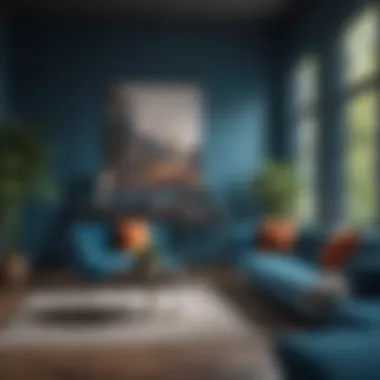
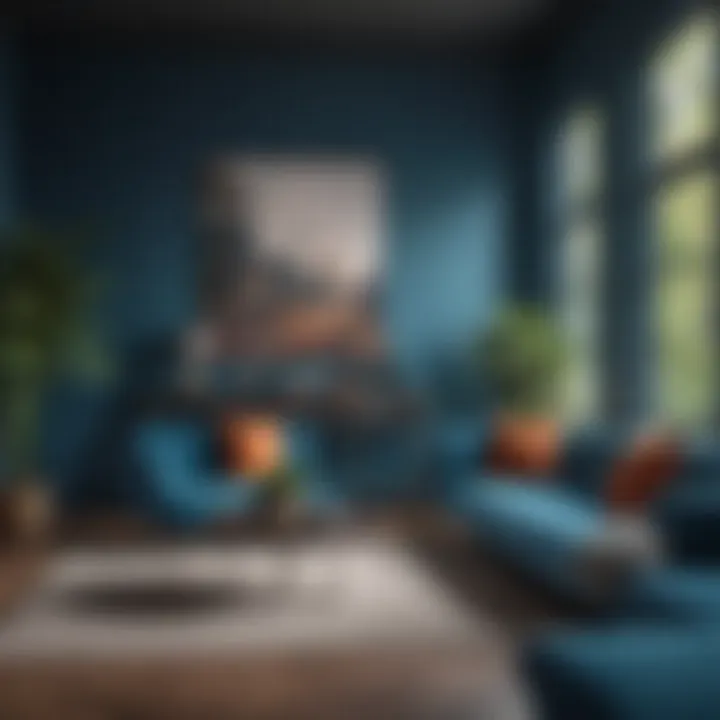
Historically, blue has played a vital role in various cultures. Its use in design can be traced back to ancient Egypt, where blue was a symbol of protection and the heavens. The use of blue pigments evolved over time, with ultramarine from lapis lazuli becoming highly prized in the Renaissance period.
In modern design, blue gained popularity in the 20th century due to its versatility. Designers began to embrace blue as a neutral color, similar to gray, which opened new avenues in color pairings and material uses. Its inclusion in the color palette of many styles signifies its enduring impact and relevance in design.
Overall, understanding the historical significance of blue enables homeowners and designers to appreciate its transformative power within living environments. Its journey from ancient times to the present reflects its adaptability and importance in the realm of interior design.
Exploring Shades of Blue
The role of blue in interior design cannot be understated. Within the context of a living room, the right shade can significantly enhance the overall ambience of the space. This section delves into the different shades of blue, exploring how each one contributes distinct feelings and aesthetics. Understanding these shades allows homeowners to make informed choices, providing clarity on how to create a desired mood.
Light Blues: Calm and Breezy
Light blue shades, such as sky blue and baby blue, evoke a sense of calmness and tranquility. They are often associated with peaceful environments and can make a room feel more spacious. Light blues reflect natural light well, which can brighten a room while promoting a serene atmosphere. Ideal for small spaces, light blue tones can create an airy feeling, making them a popular choice for coastal or minimalist themes.
When integrating light blues into a living room, consider pairing them with white or soft beige accents to enhance the open feeling. Textiles such as light blue throw pillows or curtains can further enrich the space without overwhelming it.
Dark Blues: Depth and Sophistication
In contrast, dark blue hues like navy or indigo offer depth and sophistication. These shades bring a sense of richness to a living room, making them suitable for those looking to establish a more formal or luxurious atmosphere. Dark blues tend to create a cozy environment, ideal for gatherings or quiet evenings in.
In terms of configuration, dark blue can work well as an accent wall or in furniture pieces, such as a navy sofa. It pairs beautifully with gold or brass accents, which can enhance its elegance. However, it is important to balance dark blues with lighter colors to avoid a dreary effect, ensuring enough light bounces in from windows or artificial sources.
Muted and Desaturated Blues: Subtle Elegance
Muted and desaturated blues, such as dusty blue or slate blue, provide subtle elegance. These nuanced tones are versatile and can blend seamlessly with various design styles, from rustic to modern. They maintain a calm essence while offering a bit more character compared to their lighter counterparts.
Choosing muted blues allows for a sophisticated backdrop that can accommodate various décor styles. For instance, using a muted blue as the primary wall color can serve as a neutral canvas, allowing the integration of brighter furnishings or accessories without clashing.
Color Pairings with Blue
Color pairings with blue play a crucial role in living room design. The right combinations can enhance the overall aesthetics of a space while creating a desired atmosphere. Understanding these pairings leads to a more sophisticated and well-rounded design. Colors interact in various ways, sometimes complementing each other, sometimes contrasting sharply. This interplay significantly influences the mood and energy of the environment. Selecting the right colors alongside blue can uplift the overall feel of a living room, making it inviting yet stylish.
Complementary Colors and Their Effects
Complementary colors are those that sit opposite each other on the color wheel. For blue, its complementary color is orange. This pairing creates a vibrant contrast, bringing life to the space. When used correctly, this combination can evoke energy and enthusiasm.
Some benefits of using complementary colors include:
- Dynamic Visual Interest: The stark contrast can accentuate features in the room, helping certain elements stand out.
- Balanced Energy: The balance between warm and cool can create a dynamic yet harmonious feel. The warmth of orange softens blue's sometimes chilly nature.
- Focus on Design Elements: An accent wall painted in orange next to blue-toned furniture can draw attention to specific areas, making them focal points.
In practical use, one might consider incorporating orange through accent pillows, artwork, or a rug. The idea is to maintain a balance without overwhelming the space. A splash of complementary colors keeps the atmosphere lively without being jarring.
Accent Colors to Consider
Accent colors can provide depth and texture without overpowering the primary blue hue. Selecting the right accents can transform a blue living room into a multi-dimensional and engaging space.
Here are some accent colors that work well with blue:
- White: Offers a clean, fresh look. Enhancing the brightness and lightness of the room, white creates a crisp contrast with darker blue shades.
- Gray: Provides a modern and sophisticated touch. Gray softens the blue and adds an air of elegance.
- Yellow: Adds a cheerful brightness. Yellow can introduce warmth and energy, which can be beneficial in a blue-dominant room.
- Green: Earthy greens connect interior spaces with nature. This naturally calming pairing can have a soothing effect.
Utilizing these accent colors widely expands design possibilities. Throw blankets in soft gray, yellow vases, or green plants can create layers of color that enrich the living room. These accents will enhance the sense of tranquility and style while maintaining blue as the central theme.
"The right color pairings with blue are essential for a harmonious and stylish living space."
In summary, color pairings with blue are pivotal to creating an inviting living environment. From vibrant contrasts with complement colors to subtle enhancements through accents, understanding these dynamics elevates the space's design potential. Designing with an eye for color harmonization ensures the living room resonates with personal style and comfort.
Natural Light and Blue Spaces
Natural light plays a crucial role in interior design, especially when it comes to blue-themed living rooms. The infusion of sunlight can dramatically affect the perception of blue hues. The interplay between natural light and blue tones not only enhances the aesthetic appeal of a space but also contributes to the overall mood and ambiance. By understanding how light interacts with color, homeowners can create a living room that feels vibrant and welcoming.
One key benefit of maximizing natural light in a blue living room is the ability to accentuate the different shades of blue. Light blues, such as sky blue or powder blue, tend to reflect light beautifully, creating an airy and serene atmosphere. Darker blues may absorb more light, resulting in a cozy, intimate setting. Thus, the direction and intensity of natural light should be carefully considered when choosing blue for walls or décor.
Considerations for Natural Light in Blue Spaces:
- Orientation: North-facing rooms may receive cooler light, while south-facing areas often get warm and bright sunlight.
- Window Treatments: Choosing sheer curtains or blinds can help diffuse sunlight, softening the brightness without completely blocking it.
- Color Selection: Lighter shades of blue might work better in rooms filled with natural light, while darker blues may suit spaces with controlled lighting.
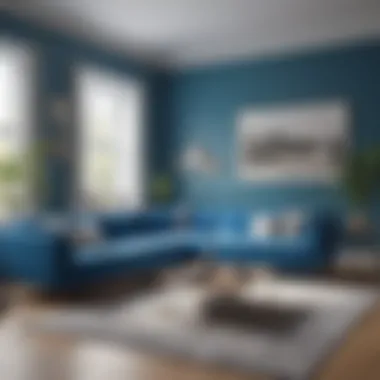
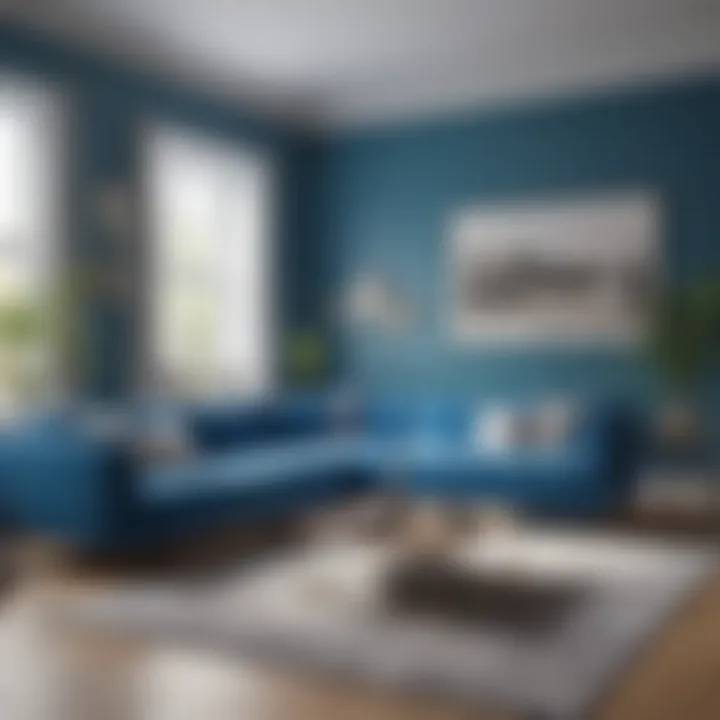
Incorporating mirrors or reflective surfaces can also enhance the effect of natural light. Mirrors can amplify daylight, creating the illusion of a larger space and brightening up darker areas. This is particularly useful when working with dark blue tones, where reflections can counteract any overwhelming effects.
The Role of Lighting in Enhancing Blues
Natural light indeed illuminates blue hues, but the artificial lighting can further enhance their beauty. The type of artificial light you use can significantly alter how blue shades appear in a living room. Bulbs with higher Kelvin ratings emit cooler, bluer light, while warmer light can soften the appearance of blues.
Factors to consider when choosing lighting include:
- Temperature: Utilize warm white bulbs for a softer look in dark blue spaces.
- Layering: Incorporate a mix of ambient, task, and accent lighting to create depth.
- Dimmers: Using dimmer switches offers flexibility to change the mood and perception of your blue tones throughout the day.
Properly planned lighting can emphasize the vibrance of blue while providing necessary illumination for the living space.
Adjusting Blue Tones with Artificial Lighting
Unlike natural light, artificial lighting gives homeowners the flexibility to adjust the ambiance according to preferences. Different types of fixtures and bulbs can be utilized to create distinct atmospheres. For instance, pendant lights or floor lamps can draw focus to specific areas while ensuring the blue tones do not overpower the entire room.
- Cold Light: Keep cool light for energetic and open vibes, reflecting off lighter blue walls.
- Warm Light: Use warm light to induce relaxation, making deeper blue shades appear more comforting.
- Accent Lights: Highlight art or decor with targeted accent lights, enhancing the visual interest.
"The relationship between light and color is a pivotal aspect of successful interior design, especially when working with colors like blue."
Furnishing a Blue Living Room
Furnishing a living room with blue as the dominant color requires careful consideration of various elements. Blue has a unique psychological effect; it tends to create calmness and relaxation. But to truly bring out these qualities, the right furnishings play a vital role in enhancing a cohesive look. The interplay between colors, textiles, and styles can either amplify the soothing nature of blue or overwhelm the space.
Choosing the Right Fabrics and Textiles
Selecting the right fabrics and textiles is essential when furnishing a blue living room. Fabrics bring texture and warmth into the space, balancing the coolness of blue tones. Here are some key factors to consider:
- Texture: A mix of textures can create visual interest. Consider soft cottons, plush velvets, or natural linens. They can help reach a soothing ambience.
- Patterns: Patterns that incorporate blue can be effective. Geometric designs or floral motifs with blue highlights can tie the room together without clashing.
- Durability: Fabrics should also be practical. Homes with high traffic may need sturdier materials like canvas or synthetic blends that withstand wear.
- Color Compatibility: Be mindful of how other colors in the space interact with blue. For instance, cream or beige textiles can complement blue without dominating.
Choosing the right textiles not only enhances comfort but also influences how blue feels in the space. Less is more; avoid overwhelming patterned fabrics that clash with the overall decor.
Furniture Styles That Complement Blue
Selecting furniture styles to complement blue can set the tone for the entire room. Different styles can influence the ambience:
- Modern: Clean lines and minimalistic designs work well. Sleek sofas in deep navy or light azure can create a contemporary look.
- Traditional: Classic wooden furniture in warm finishes can provide a contrast to blue that is welcoming. Looking for antique pieces or those with intricate details adds character.
- Eclectic: Mixing styles can also be effective. Combine a vintage leather chair with a modern coffee table. This approach can produce unique spaces with lots of personality.
- Scandinavian: This style embraces simplicity with functional furniture and soft hues. Choose light, airy pieces with blue accents for a fresh and inviting environment.
The right furniture style can drastically change how blue is perceived within the space.
When furnishing, remember to consider the scale of the furniture in relation to the size of the room. A well-furnished blue living room should feel spacious and balanced, avoiding clutter. This conscious selection of styles leads to personal and inviting spaces that resonate with the peace inherent in blue.
Wall Treatments and Blue Hues
Wall treatments significantly influence the overall ambiance of a living room, especially when blue is the dominant color. The choice of wall treatment can enhance the visual appeal of blue hues and reflect personal style and preferences. A wall treatment can vary from simple paint to intricate wallpaper designs, allowing homeowners to create unique spaces. The right treatment can elevate the mood, making the room feel more spacious, inviting, or sophisticated.
Painting Techniques for Blue Walls
When considering paint for blue walls, various techniques can be employed to achieve desired effects. These techniques include:
- Single Finish: A uniform blue shade can create a serene and cohesive look. For instance, soft light blue can give a tranquil atmosphere, while dark blue adds depth and comfort.
- Ombre Effect: This technique involves blending different shades of blue. The gradual transition can give walls an organic feel. It draws the eye upwards and can make the space feel larger.
- Stripes or Patterns: Adding stripes or other patterns in complementary colors can create rhythm in the room. These patterns can break monotony and add visual interest without overwhelming other decorative elements.
- Textured Paints: Textured options, like sponge or rag rolling, can add dimension to blue. They reflect light differently and can change how colors appear at different times of the day.
It's essential to consider the room's lighting, as natural and artificial light will alter how the blue looks on the walls. Testing samples on the walls before making a final decision is wise to find the perfect match for your desired ambiance.
Wallpaper Options Featuring Blue Patterns
Wallpaper is another effective way to incorporate blue into your living room. There are countless designs available, from modern geometrics to traditional florals. Choosing the right wallpaper can showcase personal taste while enhancing the room's character. Some popular options include:
- Floral Patterns: Light blue floral wallpaper can evoke feelings of calmness and natural beauty. This option works well in spaces designed for relaxation.
- Geometric Designs: Bold geometric patterns in dark blue can make a contemporary statement. They serve as a great backdrop for modern furniture.
- Textured Wallpapers: Options, like grasscloth or embossed designs, can add both texture and depth to walls, enriching the blue hues used throughout the room.
- Mural Wallpaper: These create an immersive experience. Murals featuring blue skies, oceans, or abstract artwork can serve as focal points, transporting someone to a different place every time they step into the room.
When applying wallpaper, attention to detail is key. Proper installation not only ensures durability but also enhances the pattern's functionality and visual appeal.
"Incorporating blue through wall treatments allows a homeowner to play with emotions and aesthetics, serving as a canvas for creativity."
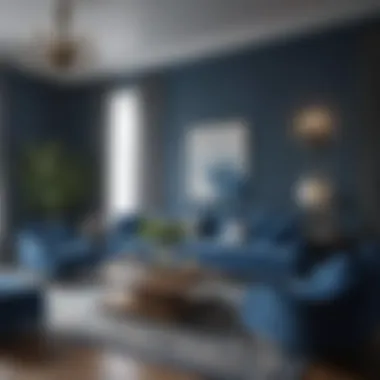
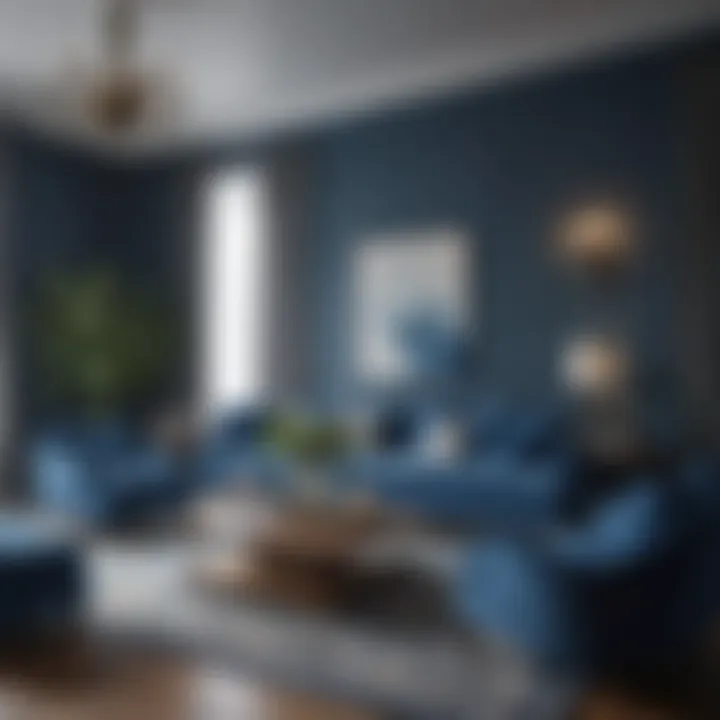
Ultimately, wall treatments are crucial in setting the tone in a blue-themed living room. Careful consideration of painting techniques and wallpaper choices can define the elegance and functionality of the space.
Decorative Elements in Blue
Incorporating decorative elements in blue within a living room aligns with the overall theme of tranquility and elegance that the color symbolizes. Decorative aspects go beyond mere aesthetics; they can profoundly influence how a space feels and functions. From artwork to cushions, each element plays a crucial role in creating a cohesive design. Consideration must be given to the selection, placement, and style of these items.
Art and Accessories: Choosing Complementary Pieces
Selecting art and accessories that resonate with blue tones can enhance the ambiance of the living room. When choosing artwork, opt for pieces that reflect shades of blue or utilize textures that can complement the primary color theme. Artwork can be framed in colors that harmonize with the blue walls. For instance, gold or natural wood frames can add warmth to a predominantly cool color palette.
Accessories such as vases, throw pillows, and rugs should also follow suit. Patterns that incorporate various hues of blue along with neutral colors can create visual interest without overwhelming the space. Additionally, large art pieces can serve as focal points. They draw attention and provide a balance to the room. Always consider the scale of the art in relation to other furnishings.
Incorporating Plants and Natural Elements
Bringing in plants can invigorate a blue-themed living room. Greenery adds life and variety, creating a more inviting atmosphere. Popular choices include snake plants, peace lilies, or succulents, each offering unique contrast to blue tones. When selecting pots or planters, consider materials that highlight the aesthetic of the room. White ceramic pots or wooden planters can beautifully blend with blue decor.
Natural elements can extend beyond plants. Incorporating elements such as driftwood, stones, or bamboo can enhance the organic feel of the space. These materials soften the edges of blue walls and furniture, creating a comfortable environment.
In summary, choosing the right decorative elements in blue involves mindful selection and thoughtful integration of art, accessories, and natural components. Each piece contributes to a refined, cohesive space while allowing for personal expression. Being aware of the interplay between these items aids in achieving the desired atmosphere.
Common Mistakes in Blue Living Room Design
Designing a living room around the blue color palette can be both rewarding and challenging. While blue offers calming effects and aesthetic versatility, it is crucial to consider common mistakes that can detract from the intended atmosphere. Understanding these pitfalls can significantly enhance the execution of your design vision, ensuring a harmonious space that feels inviting and balanced.
Overwhelming the Space with Blue
One of the most frequent errors when working with blue in living room design is overdoing the hue. While it might seem appealing to envelop every surface in a bold shade, such abundance can lead to a chilling effect that feels unwelcoming. A room saturated with blue might generate a sense of claustrophobia rather than comfort.
To avoid this, consider the following strategies:
- Limit the Application: Instead of painting all walls in deep navy or cobalt, try painting just one accent wall or limiting blue to smaller decor elements.
- Mix with Neutrals: Pair blue with neutral colors, like whites, grays, or beiges, to create breathing space within the design.
- Vary the Shades: Incorporate different shades of blue alongside other colors to prevent monotony and to add intrigue.
These methods can help to maintain blue's essence while making the space more inviting and less overpowering.
Neglecting Balance and Proportion
Balance and proportion are vital in interior design. When integrating blue, it is crucial to ensure that the distribution of color is harmonious with other elements in the room. The risk here is that one color may overpower or dominate the space, diminishing the overall aesthetic appeal.
Here are steps to ensure balance:
- Distribution of Color: Use blue in various forms – from textiles like cushions and throws to artwork and rugs – allowing it to be present without dominating.
- Consider Scale: The size of blue elements should correlate to the room’s dimensions. Large furniture pieces should not be exclusively blue unless they are strategically balanced with lighter items.
- Create Visual Anchors: Employ contrasting elements, such as furniture in complementary colors, to create a focal point that breaks the blue palette.
Keeping these principles in mind will help protect the space's integrity and make your design more effective and aesthetically pleasing.
"Understanding the common mistakes in blue living room design can help homeowners create a vibrant yet soothing atmosphere without falling into the trap of overwhelming the space."
Epilogue and Future Trends
The conclusion of this article carries great significance, as it summarizes the insights gained from exploring blue in living room design. The color blue, with its diverse shades and psychological impacts, consistently proves to be a valuable choice for home decor. Moreover, understanding future trends related to blue can influence design decisions going forward.
For one, trending interior design styles increasingly embrace varied hues of blue, from soft pastels to deep navy. The versatility of blue means it can fit into a range of aesthetics, from modern minimalist to traditional contexts. As homeowners seek to create more personalized spaces, incorporating blue can foster a sense of calm, evoking serenity and relaxation.
Benefits of Embracing Blue in Design:
- Adaptability: Blue suits various decor styles and environments.
- Psychological Comfort: The calming nature can enhance the mood of a space.
- Timeless Appeal: Blue's classic presence ensures relevance over time.
As we look to the future, there are important considerations. Sustainability in design is on the rise, leading to a focus on eco-friendly paints and furnishings in blue. Furthermore, advancements in technology allow for innovative design solutions that incorporate blue in unique ways, like smart lighting that adjusts the tone of blue based on the time of day.
"Incorporating blue into living spaces is not just about aesthetics; it is also a move towards creating healthier, happier home environments."
The Evolving Role of Blue in Design
The role of blue in design is evolving, reflecting cultural shifts and personal preferences. Historically, blue has been associated with trust and stability, which continues to resonate today. Its integration into furniture, textiles, and wall treatments is becoming more nuanced.
Interiors are not just about color; they tell a story. As more individuals focus on wellness and mental health, blue is seen as a therapeutic hue. With a varied palette, designers can now use blue to create moods that align with the intended purpose of a room, enhancing functionality while preserving style.
Final Thoughts on Incorporating Blue
Incorporating blue into a living room requires a thoughtful approach. It is not merely about painting walls or selecting fabrics. It involves a comprehensive consideration of how blue interacts with light, space, and furnished pieces.
Homeowners are encouraged to experiment. Start with accent pieces if unsure, then gradually integrate larger elements like furniture or artwork. Remember, the goal is to create a harmonious environment where blue contributes meaningfully to the overall design.















